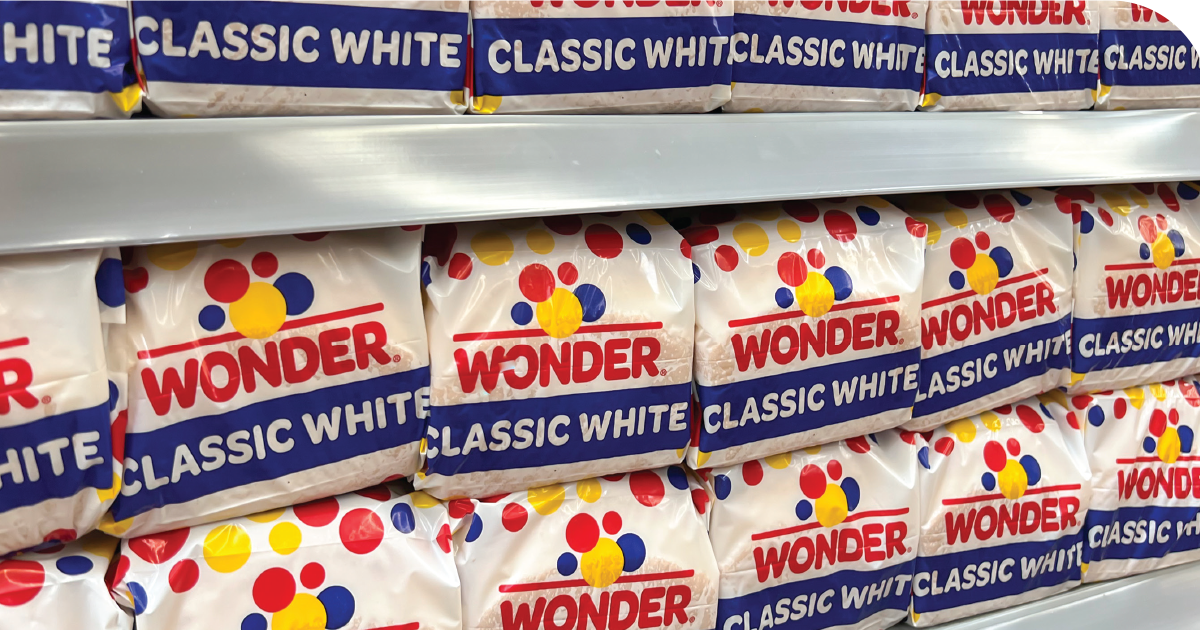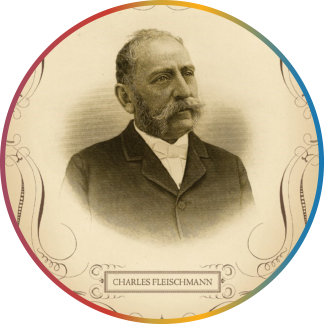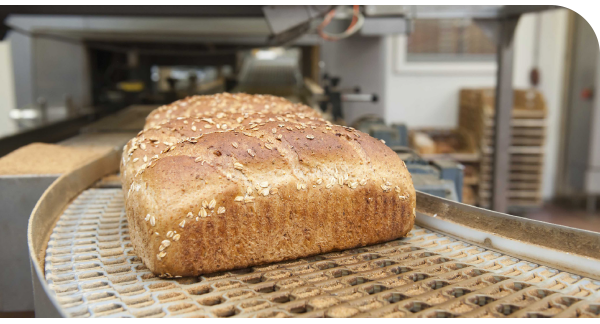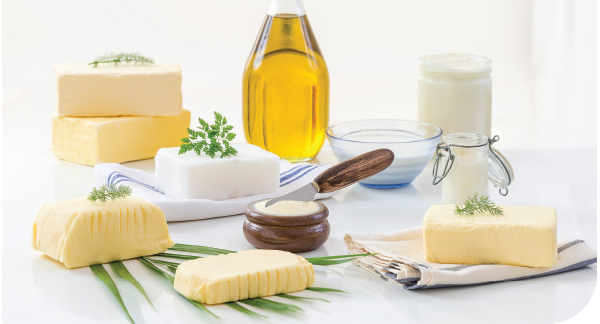By Charlotte Atchley
June 2022
Catalysts
for change
The pressures of regulation and consumer demand have led to significant advances in food science for the baking industry.


©JHVEPhoto – stock.adobe.com
Innovation comes from many places. Sometimes it’s born out of need: a new regulation nullifies the use of a reliable ingredient. Other times it comes from an individual asking the simple question: Does it have to be this way? Occasionally, a person just wants to recreate the bread of their homeland in their new country.
Regardless of how innovation starts, it can be revolutionary. And the baking industry has seen much transformation over the past 100-plus years, from the commercialization of yeast to the many ingredients that make automated bakery production possible. Bakers and food scientists have been tinkering and reformulating to find new ways to reduce saturated fat, make whole grains more palatable and meet consumers’ ever-changing demands for less additives and more natural, healthful — but delicious — baked goods.
You might also enjoy:
Overcoming obstacles and chasing innovation, the pet food industry prepares for its promising future.
Looking ahead, producers, processors and retailers must appeal to evolving demographics.
Argentina-based company has made major inroads with HB4 wheat in Argentina, has sights set on Australia and the US
Standardizing the rise
More than one hundred years ago, the commercial baking industry was born from a culmination of many technological advancements. Milling technology improved to enable large-scale flour production. The industrial revolution brought about equipment that allowed bakers to use up all that flour and commercially bake bread. The commercialization of yeast by the Fleischmann family, however, standardized a chemical reaction that until that point had largely been guesswork and accident.
The Fleischmanns certainly didn’t invent yeast. In 1857, it was Louis Pasteur who discovered what yeast could do. By studying fermentation, Mr. Pasteur confirmed that yeast was a microorganism, and that it converted sugar into alcohol and carbon dioxide. He also found out that yeast contaminated with Lactobacillus produced a souring lactic acid, and that if air was added during the fermentation process, the yeast would multiply. While these discoveries led to Mr. Pasteur’s contributions to medical science, it also provided every industry that uses yeast the foundational scientific knowledge to harness specific strains and make them more consistent.
Enter the Fleischmann family, specifically brothers Charles and Max. Distillers by trade, Charles and Max Fleischmann immigrated to the United States from their native Austria in 1866. After establishing themselves in the US, the brothers saw a need in their new home in Cincinnati to provide European-style bread to their Austrian-German community. They partnered with James Gaff to develop, manufacture and sell compressed yeast from a strain brought from Austria for both commercial and home bakers. The brothers and Mr. Gaff founded Gaff, Fleischmann & Co. in 1868.
“Yeast fermentation and baking are very scientific processes,” said Michelle Brodie, director of yeast technology of AB Mauri North America, which currently owns the Fleischmann’s brand. “Consistency is key to ensuring our customers are putting out the same product week after week.”
The next scientific advancement in yeast was the invention of active dry yeast. In 1933, Harold Allden Ander invented the process that would dehydrate fresh yeast while maintaining its functionality. Standard Brands, which owned the Fleischmann’s brand at the time, patented the process and launched Fleischmann’s Active Dry Yeast. This added months to the shelf life of yeast, removing concerns from commercial bakers about losing the viability of the fresh yeast they were purchasing. All they needed to do was simply rehydrate the dormant yeast.
In 1984, Fleischmann’s would make yeast even easier to use with its RapidRise Instant Yeast. This ingredient could simply be added to the mixing bowl and deliver the rise bakers needed.
“What revolutionized the industry was when Fleischmann’s developed the dry yeast because you could just add it to the dough mix,” Ms. Brodie said. “Then they continued to revolutionize by developing the fast-rising dry yeast. Bakers could just add it to the dough mix without hydration. These dry products are now staples.”

Back and forth with fats
No other major ingredient category may have had more ups and downs in the past 100 years than fats and oils. These ingredients aren’t critical to every bakery application — most bread formulations don’t require much if any fat. But for those bakery applications that do need fat — cakes, donuts or laminated doughs — these ingredients do a lot of heavy lifting.
Every time fats and oils have had to shift to appease health-conscious consumers or the US Food & Drug Administration, the baking industry has waited with baited-breath to see if the latest replacements would hold up to previous standards.
Originally, bakers used butter or lard, traditional animal fats, to provide lift and flavor to their baked goods, or the perfect fry on their donuts. In 1911, the development of Crisco — the first commercially produced partially hydrogenated oil — and the heavy marketing push around the new ingredient to home bakers, began the fall of animal fat. It was cheaper than animal fats with similar functionality and began outpacing lard as the fat of choice for home bakers.
Partial hydrogenation enables bakers to use vegetable oils as shortening. The process converts vegetable oils into solid forms of varying plasticity. Unlike simply blending vegetable oils, hydrogenation also improves the shortening’s resistance to oxidation and rancidity.
“Those shortenings provided the tenderness, structure and mouthfeel consumers expected,” said Frank Flider, oils consultant for the United Soybean Board. “When PHOs went away, the problem became matching the performance we had with PHOs and animal fats and developing shortenings that had the same characteristics that bakers are used to.”
Unlike animal fats, which gain their functionality from saturated fat, PHOs use trans fats to get those same characteristics. In the 1950s when saturated fat was linked to cardiovascular health, PHOs became even more in vogue as a way to eliminate saturated fats from baked goods. However, when new science found trans fats to be even more hazardous to human health than saturated fats, the FDA stepped in.
In 2015, the FDA revoked the Generally Recognized as Safe (GRAS) status of PHOs. The baking industry had three years to remove PHOs from their formulations, except in the instances of using small amounts of PHOs as a food additive, for example, as a carrier for colors and flavors.
Replacing PHOs created not just a formidable challenge but an opportunity for a wealth of innovation. From it has come many ingredient technologies and formulating strategies to create custom fats and oils. To date there is no drop-in PHO replacement that works across all applications. Food scientists have relied on blending multiple base oils, emulsifiers, high-oleic base oils and interesterification to create custom shortenings that deliver the same functionality as PHOs. Fully hydrogenated oils contain no trans fatty acids and have been useful as food scientists blend them and use interesterification to create custom shortenings to replace partially hydrogenated counterparts.
With PHOs successfully replaced with custom blends, bakers are now turning toward continued reduction of saturated fats as well as finding more sustainable fat and oil ingredients.

A stronger dough
While commercial yeast would provide a consistent, easy-to-achieve rise for commercial bakers, the equipment producing the baked goods would require stronger formulas to handle the stress.
“Continuous bread production that we see today requires more tolerance from the formulation,” said Yangling Yin, PhD, director of RD&A, ingredient solutions, Corbion. “Doughs running in these continuous production runs require quite a bit of dough strength.”
The baking industry turned to dough conditioners — which provide several functionalities including strengthening, relaxing and softening — to provide that strength. Emulsifiers like DATEM, SSL, mono- and diglycerides showed that they could improve the texture and tolerance of doughs that were produced in 3,000-loaf batches.
These emulsifiers have been around a long time, though they have cycled through as standards for formulating throughout the years. Industrial-scale emulsifiers have been around since 1920, specifically monoglycerides since 1934 and DATEM since 1960. In 1958, the FDA granted GRAS status to improve ingredients in general use.
Since then, new legislation has eliminated the use of some of these ingredients, as is the case with potassium bromate. While this ingredient proved useful as an oxidizing agent that strengthened the dough, it is banned in many countries around the world including the European Union. The US has yet to outright ban the ingredient, though the FDA has encouraged bakers to voluntarily stop using it, most of which have complied. Since then, other emulsifiers like DATEM and SSL took a turn in the spotlight, according to Dr. Yin.
However, as consumers continue to expect cleaner ingredient labels, bakers have been looking for other options to provide the same level of tolerance, texture and shelf life as emulsifiers.
“When clean label came on as a trend a few years ago, people in the industry thought it would come and go just like other passing trends,” Dr. Yin said. “But it’s not going to go away. The next generations want it, and the clean label trend will only grow stronger.”
Clean up on aisle 65
The movement toward clean label, generally defined as ingredients consumers readily recognize, has led to many exciting ingredient innovations as bakers rush to remove stand-by ingredients that have enabled the commercial scale production of baked goods. Clean label as a term doesn’t have a regulated meaning, though many companies base their clean label formulation decisions on what is accepted at retailers such as Whole Foods or regulations such as California’s Safe Drinking Water and Toxic Enforcement Act of 1986, also known as Proposition 65.
Proposition 65 requires companies to disclose whether their products contain any of the 900 substances included in its list of toxic chemicals, or those that could cause cancer, birth defects or other reproductive harm at significant exposure. This disclosure includes a regulated warning label, and companies found omitting the warning could be fined up to $2,500 per day for each violation. While this law technically only applies to products sold in California, many companies include the label on all products sold in the US as a precaution if they contain a listed chemical. Ideally, however, companies reformulate their products, which has led to much innovation in the baking industry, specifically around enzymes.
“Labeling became an issue; people were shocked to read all those chemical terms on their bread labels,” said Kees Docter, retired senior director of technical services for Lallemand Baking. “But with enzymes, it’s just enzymes, which are naturally occurring.”
Mr. Docter’s longtime colleague Jan van Eijk, PhD, retired research director of Lallemand Baking, spent much of his 38-year career developing enzymes for the baking industry as it strove to find clean label solutions for dough conditioning and shelf life. After joining Lallemand Baking, Dr. van Eijk moved to the US from The Netherlands where he saw the clean label movement begin to pick up steam. With his experience baking in Europe, where chemicals like bromate had already been removed, he applied his knowledge to developing enzymes for the US baking industry.
“We wanted to be the first to the clean label solution,” Mr. Docter said. “We saw that coming, and we wanted to be first, and with our experience making bread in Europe, we knew we could do it.”
The game changer for enzymes, in Dr. Yin’s opinion, was the ability to use genetically modified substrates to gain control of enzymes. Before this time, about six or seven years ago, enzymes were difficult to control. They’re sensitive to their environment, and bakeries are inconsistent places with changing ambient temperatures, humidity and flour quality. Harnessing enzymes through GMO substrates made these ingredients more consistent and easier to use.
As consumer demand has pushed the industry toward enzymes, cost has also played a factor.
“There’s not just a label improvement but a cost reduction,” Dr. Yin said. “The gluten shortage, for example: gluten by itself is very expensive. We’re not even talking about the availability issue, but it’s just not sustainable in this crisis. People are looking at enzymes as a sustainable and cost-saving solution.”
With the commercialization of enzymes bakers have been able to move from emulsifiers to strengthen dough, soften dough and even extend shelf life, where the baking industry continues to reach new heights.
Changing the game with ESL
Extended shelf life (ESL) radically changed the way the baking industry did business. The research and development team at Interstate Bakeries Corp. (IBC), Kansas City, Mo., led by Theresa Cogswell, was able to develop a proprietary enzyme blend that enabled them to double Wonder Bread’s shelf life to seven days from four. Ms. Cogswell recalled that no one was quite sure what to do with such a revolutionary product when bread previously barely lasted longer than the daily paper.
“No one at IBC knew how to implement it,” said Ms. Cogswell. “The execution of ESL Wonder Bread came from Walmart. They no longer had to stack bread by the day of the week; they could now mass merchandise the bread.”
In an interview with Milling & Baking News, then President and Chief Executive Officer Chuck Sullivan laid out the benefits for retailers:
“Retailers, including Walmart, define full service as a full shelf. The positive side for the retailer is that the shelves remain full all the time, as opposed to the short shelf life we had before.”
While speaking to analysts in an investor call on September 19, 2001, Mr. Sullivan showed that ESL had reduced stale returns from 12% to 15% to 6% to 7%. He also elaborated on how this innovation would impact routes, deliveries and operational efficiencies.
“It essentially reduces the amount of product we have to pick up; it increases productivity of routes; it results in fewer routes,” he said.
Ms. Cogswell remembers the room full of maps with pins all over to show those different delivery routes.
“The guys would be in there repinning the routes because they didn’t have to deliver bread as often,” she said.
Ms. Cogswell recalled that the company saved $60 million that first year of ESL Wonder Bread. Despite the pushback she received (she remembered being told multiple times she would single-handedly destroy the baking industry), Ms. Cogswell’s passion project changed the game on the way bread was not only merchandised but produced and delivered.
“I never understood the bakery business model,” she said. “We would bake 100 loaves of bread and intentionally be okay with losing three to five loaves due to staling because we couldn’t sell them by the expiration date. …
“I credit my mother with this achievement because she never wasted anything, and I used to look around at all the waste and stales in the bakery and wonder, ‘Does it really have to be this way?’ ”
And that’s the big question that every innovator asks themselves and the industry. The answer carries the baking industry into the future of taste, nutrition and better operations.

